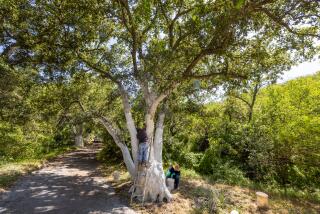Don’t Risk a Coup Against Monarch : There Are Too Many Unknowns to Gamble With Butterfly’s Sensitive Habitat
- Share via
There’s hardly a schoolchild who hasn’t studied the monarch butterfly, a boldly beautiful insect.
Monarchs are fascinating in another way. They are one of the more migratory insects, traveling thousands of miles to escape cold weather. To accomplish this astonishing feat, monarchs need safe places to harbor. They choose groves of trees with the right combination of air temperature, humidity and sunlight.
There are about 100 such sites in California, six of of them in Orange County. One, a grove of pine trees at Emerald Bay in Laguna Beach, is located on land where Brinderson Real Estate Group of Irvine wants to build 27 luxury homes.
It is estimated that 3,000 to 5,000 monarchs roost there in the winter--few compared to other sites where tens of thousands gather. But monarch protection groups fear that if the roosting sites are destroyed one by one, the butterflies and their migration pattern may be endangered.
A spokesperson for Brinderson says the monarchs cluster in three trees, which the builder is willing to preserve. But would that subject the butterflies to more wind, or sunlight, than they could survive? How about the effect of the changes in humidity, or human activity nearby? These are questions that remain unanswered.
A 100-page county environmental impact report on the project includes two paragraphs on the monarchs. The county must do a more thorough study of these roosting sites.
Because the monarch is so common, it’s assumed they are safe from extinction. But comparisons are made to the passenger pigeon, which were once prevalent in the United States, but were shot from the air by the dozens and now are extinct.
Until the true impact of altering migration sites on the monarchs is known, it is better to err on the side of caution and make development accommodate these nesting sites by preserving more than just three trees.
More to Read
Sign up for Essential California
The most important California stories and recommendations in your inbox every morning.
You may occasionally receive promotional content from the Los Angeles Times.













